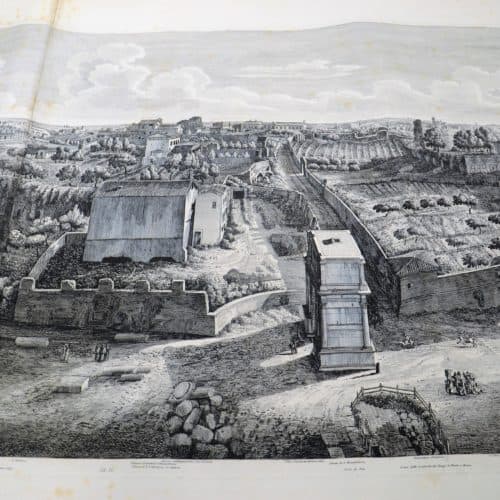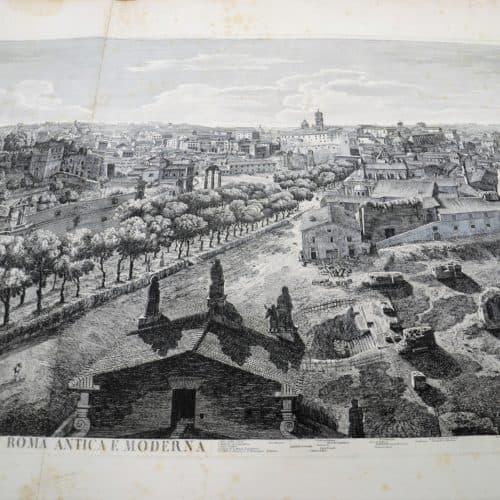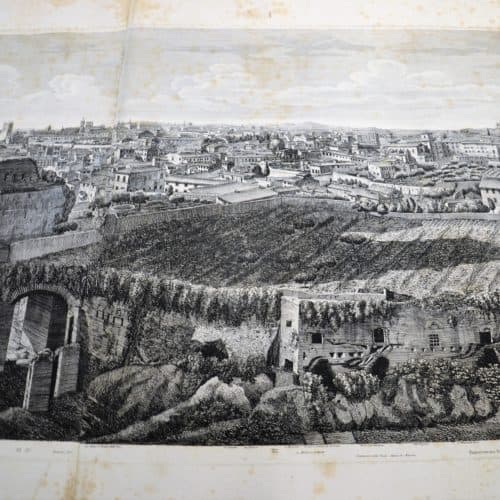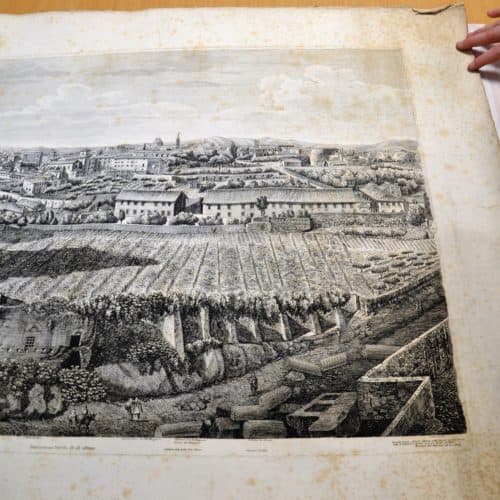Master Collection 9: 'Panorama of Rome'
Panorama of Rome, 1827, by Luigi Rossini (1790-1857). Etching on paper.
It’s a panorama of Rome in the early 19th century, including lots of impressive Roman remains.
It’s an impressive size… several metres long. The people visible at the top of the photograph give a good indication of scale.
A panorama is a 360 degree view. There are now apps on mobiles and other digital cameras that stitch together a series of pictures into a panorama. But in the past an artist had to make a series of drawings looking in different directions and join the views by hand.
Large-scale panoramas of cities and battles (like 360 degree cinema, but painted) were hugely popular in the 19th century.
The panorama is so wide, that we’ll explore it, from left to right, in 5 separate images.
The Roman amphitheatre in the background is the Colosseum. It got its name either because of its enormous size or its proximity to a colossal statue of the Roman Emperor Nero that stood nearby. The gilt-bronze statue was 33 metres high!
The Colosseum is elliptical – shaped like a squashed circle. It began to be built under Emperor Vespasian in 70-76 AD and was completed by his son Titus. A fourth storey was added during restoration about AD 230 under Alexander Severus.
When it opened, over 5,000 wild animals and many gladiators were killed in fights staged for packed crowds.
Although Christians were thought to have been martyred in the arena, there is no historical evidence for this. However, the Pope declared in 1749 that the Colosseum had been sanctified (made sacred) by the blood of martyrs and people stopped pillaging it for building stone. This helped preserve what remained.
Fascinating fact
Richard Deakin, an amateur botanist working as a physician in Rome, made a study of the plants growing in the Colosseum, which he published in 1855. He found there were 420 different species, 56 of them grasses. Some species were native to Africa or Asia and not found elsewhere in Italy; Deakin thought these likely to have been brought by exotic animals that the Romans imported… and which were used in wild animal fights in the Colosseum.
- Can you spot a Roman triumphal arch to the right of the Colosseum? This is the Arch of Constantine.
The fountain in the foreground stands in front of large Roman ruins, which are part of the Temple of Venus and Rome. This was built by Emperor Hadrian on the site of the entrance to Emperor Nero’s Golden House (Domus Aurea). A colossal gilt- bronze statue of Nero as God of the Sun had stood here. It took 24 elephants to move it nearer the Colosseum!
There are lots of ruined Roman buildings, including fallen columns and piles of stones.
The tall building, we can see from the side in the foreground (centre right) is the Roman Arch of Titus. You can see the arch shape in its shadow.
It was built in AD81 by the Roman Emperor Domitian, as an honorific arch to commemorate his older brother Titus being raised to the status of a Roman god, and of his victory, with his father Vespasian, over the Jewish rebellion in Judaea.
It contains panels depicting the triumphal procession celebrated in AD71 after the Roman victory and fall of Jerusalem.
The Panoramma di Roma, Antica e Moderna (Panorama of Rome, Ancient and Modern) was sketched from the church tower of Santa Maria Nova, also known as Santa Francesca Romana.
- Can you spot the church roof in the middle foreground?
We’re looking down onto the tiled roof of the church and can see the backs of the three roof sculptures, which are completely flat! The sculptors (to save time and cost) only carved the fronts, which would be seen from the road. Most people aren’t able to go up the bell-tower and look down at the sculpture backs, as the artist did!
An oxcart and two oxen are in front of a large house in the middle of the panorama. The house looks in poor repair and there are stones from Roman ruins piled up outside.
To the right are three huge Roman barrel vaults that were part of the Basilica of Maxentius or Constantine, begun by one Roman Emperor and finished by the other. A colossal stone statue of Constantine once stood in this basilica, pieces of which are now in the courtyard of the Capitoline Museum. The barrel-vaulted remains show how Romans built ‘coffered’ arched ceilings and were very influential for many 18th and 19th century architects.
There are Roman columns in the Roman Forum (background centre). A set of three are all that remain standing of the Temple of Castor and Pollux or Temple of the Dioscuri, hero twins who helped the Romans win in battle with the Tarquins and their allies.
A temple front of eight columns are the remains of the Temple of Saturn. Near it are three columns in a right angle, which formed a corner of the Temple of Vespasian colonnade. In front of that is a single column, the Column of Phocas, set up in 608 AD to honour a centurion who had seized the throne of Byzantium.
The Forum was the beating heart of Ancient Rome filled with bustling marketplaces and imposing civic buildings. Discover some fascinating facts about it.
https://theculturetrip.com/europe/italy/articles/11-things-you-didnt-know-about-the-roman-forum/
There are at least eleven church domes to be seen across the whole panorama (many of them in this section). Most of these domes belong to churches built in the late 16th and 17th centuries, when construction projects flourished in Rome. The dome of St Peter’s Basilica, in the Vatican, is in the far distance.
This section of the panorama, with St Peter’s Basilica dome on the horizon, is looking towards the north-west. From the way the shadows of the sculptures are cast, we can tell that the sun was in the west.
Rome in the 1820s was a much smaller city than in Roman times.
In 1825 it had a population of only 138,000, compared to an estimated 1 million people at the height of Ancient Rome, and nearly 3 million people today!
That’s why it's not all built up. There’s lots of space for gardens and orchards, vineyards and farmland between the ruins.
Along the bottom of the panorama are the names of all the important buildings, churches, Roman temples you can see directly above.
Can you find the Terme Diocleziano (the Baths of Diocletian). These were the largest imperial baths in Ancient Rome. According to the ancient writer Olympiodorus, they were able to accommodate up to 3000 bathers at a time! You can still visit the remains of these baths today.
- What other building names can you find?
- Why not research them online to find out more about them.
This is the final section of the panorama. You’ve now looked all the way around: 360 degrees.
Look carefully at the wall in the bottom right corner of this picture.
Now look back to the image with the Colosseum.
- Can you find the same wall on the left side of that picture?
If you made the whole panorama into a circle the two ends would join up seamlessly!
Did you know?
Luigi Rossini, who made this panorama, originally wanted to be an architect. However, he was so impressed when he saw prints made by Giovanni Battista Piranesi that he decided to take up printmaking himself. He made more than 100 views of antiquities in Rome.






